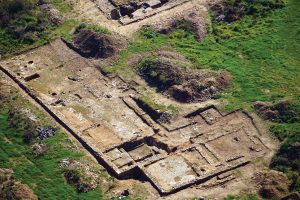Amateur archaeologists discovered and unearthed a well-preserved Roman villa filled with mosaics at Druce Farm, Dorset, South West England.

The site was discovered by a metal detectorist, who started finding Roman coins and other artefacts connected with traces of Roman settlement. Moreover, debris from destroyed structures were also discovered, what hinted on existence of a building structure. Non-invasive investigation followed with resistivity and magnetometry surveys, which revealed enclosure ditches and three ranges of buildings, and even the suggestion of an entrance. Three trenches put back in 2012 came across walls and caught enough of the northern range to realise that it was still in a fair state of preservation. After finding mosaics in the subsequent year the researchers were sure that they discovered a Roman Age villa.

The find was made in an area where a quarry started operating in 1992 and there was a need for archaeological evaluation and supervision over the 55 hectare area. Over the years the team of archaeologists and amateurs excavated an incredible landscape that had attracted successive groups from Mesolithic hunter-gatherers to modern-day farmers, with every archaeological period in-between represented.

The villa is a classic example of this building type with the main residence in form of a winged-corridor building, with a courtyard in front flanked by an aisled hall on one side and a workshop range on the other. The villa has only one wing, projecting into the courtyard on the western side. The main building contains a range of rooms with a corridor at the front. The well-preserved mosaics were found in the western end, forming part of the west wing, and there are several other mosaics in the rooms at the core of the villa. The west-wing mosaic was created in 350 AD in a style using black and white tesserae, what was fashionable in the 1st and 2nd centuries AD. The design is geometric and forms a swastika, considered a good luck symbol, at the centre. Experts believe that the artwork may have been designed by the Ilchester School of mosaicists, whose work is common in the Dorset area.

(after Current Archaeology)
Permalink //
Very nice, there are more and more waiting to discover.